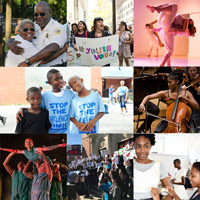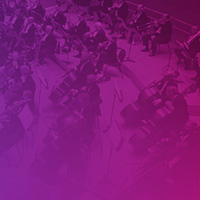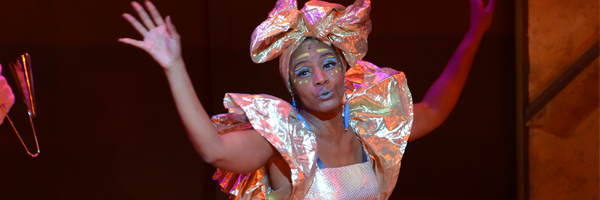
A Jamaican fairy God mama makes dreams come true for a girl born in a public housing project, in Black Ensemble Theater’s “The Other Cinderella.”
Mexican families in Pilsen commemorate their loved ones with a festival of lights and traditional altars in the park during the National Museum of Mexican Art’s annual Dia de los Muertos.
These are just two of the countless artistic offerings from Chicago institutions that focus on the cultural traditions and art forms of communities and artists of color.
Chicago has a rich landscape of artistic and cultural projects run by and/or serving people of color and operating in some economically challenged neighborhoods. But these institutions have access to a fraction of the resources available to many larger Chicago arts groups, those with primarily white leadership and audiences, as studies have shown and the people who run community-based organizations know all too well.
An innovative and growing local collaboration aims to change this imbalance.
Enrich Chicago, launched in 2014, brings together arts organizations and foundations with the aim of increasing the resources available for arts institutions led by and serving people of color. Enrich Chicago is also focused on increasing the number of people of color in arts administration positions and making arts programming more available to marginalized communities across Chicago.
There are currently 14 art institutions and seven foundations involved in this effort. And the roster continues to grow. Along with Black Ensemble Theater and the National Museum of Mexican Art, members include Hyde Park Arts Center, Steppenwolf Theater, the Puerto Rican Arts Alliance, Muntu Dance Theatre, and the MacArthur and Joyce Foundations.
An important priority for Enrich Chicago is to prepare the next generation of artists and art administrators by encouraging youth of color to consider opportunities and careers in the arts. Nationally, three-quarters of arts foundation staff are white, according to a 2013 Americans for the Arts report. More than 65 percent of Chicago residents are people of color.
The concept with Enrich Chicago is, after some training about race and racism, we collectively all head upstream and try to solve inequity where it begins.
“We have a group of folks who are aware of their differences and power dynamics and are collectively working to understand how racism has been designed into our policies and procedures,” said Field Foundation president Angelique Power, one of the founders and co-chairs of Enrich Chicago. She said organizations led by and focused on people of color are often “swimming upstream.”
“Part of the challenge today is that no one knows how to talk about race. It feels immediately tense; people are so afraid of offending and so afraid of being offended that we all codify racism because we’re just so scared of it. The concept with Enrich Chicago is, after some training about race and racism, we collectively all head upstream and try to solve inequity where it begins.”
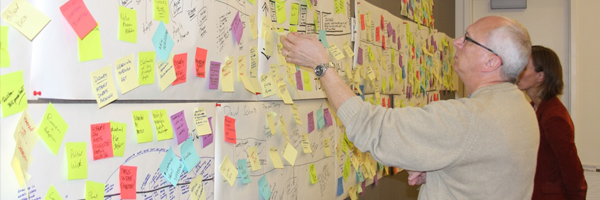
Power and others described the group’s initial meeting as “explosive” and difficult at times, because people talked frankly about sensitive issues. It was hard for some people, especially individuals who see themselves as progressive and open-minded, to acknowledge their institutions could be furthering racial inequality.
Bau Graves is executive director of the Old Town School of Folk Music, an Enrich Chicago member which does not exclusively serve communities of color but has a deep commitment to equity and diversity.
“We’re talking about white privilege, and there’s an awful lot of guilt,” Graves said. “Both my sets of grandparents were coal miners. They had a hardscrabble existence. But they were able to send their kids to college and I had a lot of opportunities to live a culturally-enriched life not available to huge numbers of kids in Chicago. Being part of Enrich Chicago has radicalized me and shown me how much I’ve benefited from things that other people don’t have access to.”
As Americans there are a series of techniques we have to avoid talking about race. The workshop did a good job of closing off those escape hatches.
Such discussions are a central part of Enrich Chicago’s mission. Leaders and representatives of arts organizations and foundations meet every six weeks and informal discussions and partnerships take place on an ongoing basis. Enrich Chicago also occasionally hosts three-day “Undoing Racism” trainings for participants.
“As Americans there are a series of techniques we have to avoid talking about race,” Graves said. “The workshop did a good job of closing off those escape hatches.”
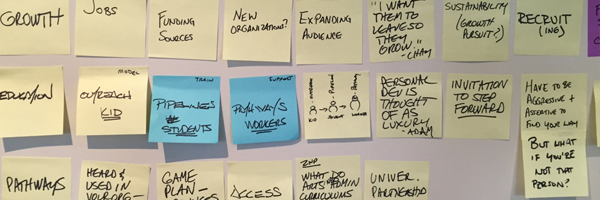
Enrich Chicago is working with the Social Impact Research Center to get a clearer picture of the state of foundation funding for arts groups of color in Chicago. It plans to use the research as a platform to discuss how foundations can potentially address gaps. The study also aims to illuminate the needs of these organizations given their lack of financial resources and other challenges they face.
Arts organizations are typically funded from five sources: government grants, foundation grants, corporate funding, donations from private individuals, and earned income. Donations by private individuals make up the largest source of funding, accounting for 30 to 40 percent according to studies. But organizations led by and serving people of color rely primarily on foundation funding, since wealthy individuals capable of making large private donations tend to give most to long-standing, large institutions whose leadership is likely to be primarily white.
Enrich Chicago is focusing on foundations since they are the primary funding source for organizations of color, and because foundations may have a better-defined social mission and sense of public accountability.
A study by the Helicon Collaborative found that nationwide, close to 25 percent of nonprofit cultural groups focus primarily on serving people of color, low-income communities, lesbian, gay, bisexual, transgender, queer populations, and the disabled. But such groups receive only 7 percent of foundation arts giving. Nearly 60 percent of all arts funding is directed to just 2 percent of institutions, whose audiences are predominantly white and upper income, the study found.
We argue that arts is central to the human spirit, and it’s also central to democracy.
Black Ensemble Theater founder and CEO Jackie Taylor said foundations should invest in sustaining organizations in communities of color for the long-term, rather than around specific projects or goals. “This is our life; this is what we do,” she said.
Enrich Chicago members agree that while increasing funding and representation are long-term, concrete goals, more dialogue, and relationship-building among the partners are important near-term strategic steps. Black Ensemble Theater Associate Director Daryl D. Brooks said arts organizations led by people of color want a seat at the table where larger decisions are made and priorities are hashed out.
“We argue that arts is central to the human spirit, and it’s also central to democracy,” said Carlos Tortolero, Founder and Executive Director of the National Museum of Mexican Art. “Right now our democracy is in danger. I do think there’s a wake-up call now; we all need to understand each other and work together.”
MacArthur is a member of Enrich Chicago and supports the collaboration through a $75,000 grant in 2016 to the National Museum of Mexican Art. MacArthur provided $11 million in support to more than 300 Chicago arts groups in 2016.



